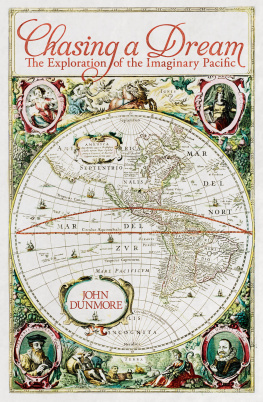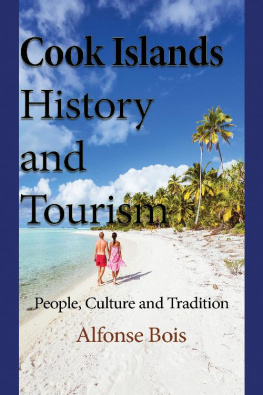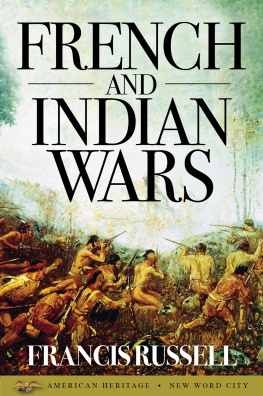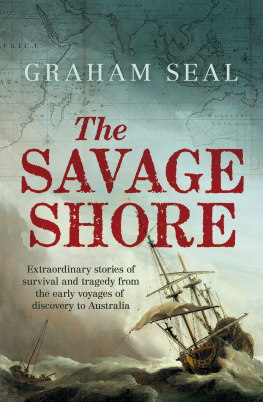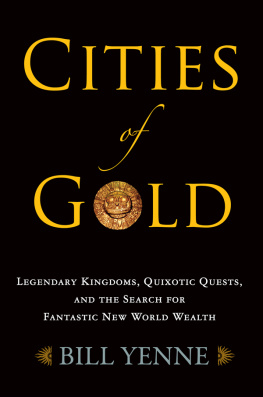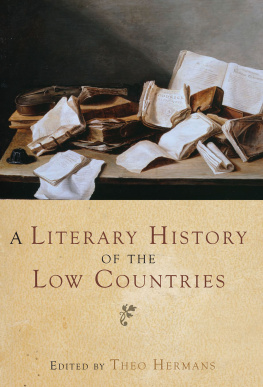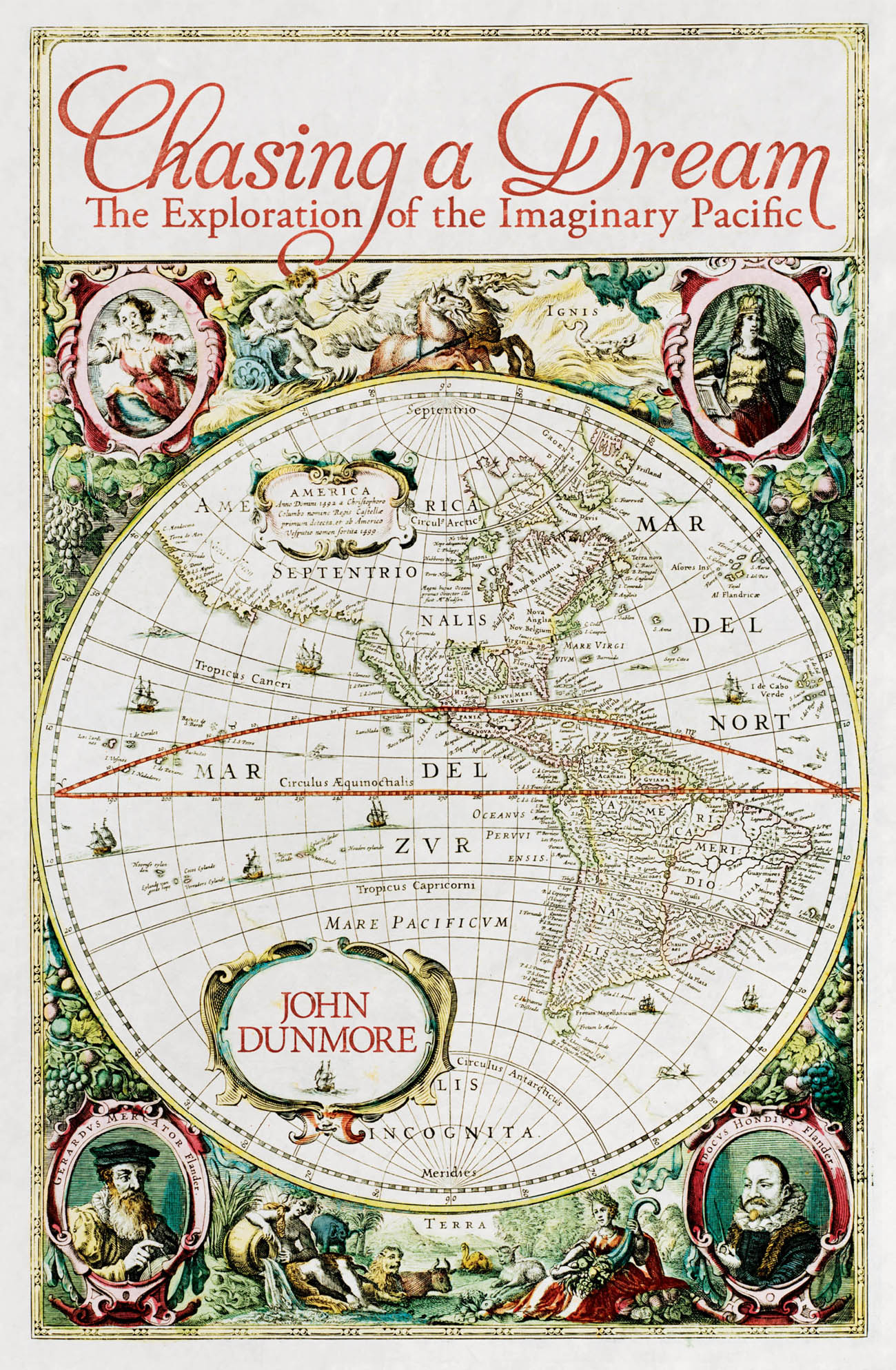A catalogue record for this book is available from the National Library of New Zealand
ISBN 978-1-927262-84-9
An Upstart Press Book
Published in 2016 by Upstart Press Ltd
B3, 72 Apollo Drive, Rosedale
Auckland, New Zealand
Text John Dunmore 2016
The moral rights of the author have been asserted
Design and format Upstart Press Ltd 2016
All rights reserved. No part of this publication may be reproduced or transmitted in any form or by any means, electronic or mechanical, including photocopying, recording, or any information storage and retrieval system, without permission in writing from the publisher.
E-book produced by CVD L imited
Contents
Preface
The history of navigation and exploration is full of mysteries and confusion. Mans efforts to discover his own environment and what surrounds it have always been affected by his imagination. Throughout the centuries, the hardships of daily life, the fear of a bleak and dangerous future, the hope of survival, made him dream of a better world, a more fertile land, a more settled and peaceful society. As the song has it, Somewhere over the rainbow... there must lie a happier and safer land.
Each generation necessarily builds its dreams on what the previous one achieved or failed to achieve. The explorer who sets out, whether by land or sea, takes with him in his slim baggage the knowledge that his elders have passed on. And naturally he also carries his own hopes.
Yet how reliable is that knowledge? Did Saint Brendan, the Irish monk, really discover America? Did he truly set off in a curragh into the North Atlantic, make his way around Iceland and sight the coast of North America? And why did he set out on this journey when he apparently was already in his sixties? He was, so tradition has it, looking for the Land of Promise of the Saints.
His voyage contains all the elements one finds in early exploration. There is a burning need to discover, whether it is for ones own benefit, or for the good of others, including the moral salvation of unknown people, and for the general advancement of knowledge. The outcome is the discovery of strange places, filled with mysteries and legends, which later generations will come to believe in, yet will be unable to rediscover. In Brendans case, it was the Sargasso Sea and a handful of islands, including one that turned out to be a giant sleeping fish. And the whole was preserved and well embroidered in a major piece of writing, the Navigatio Sancti Brendani .
Narratives, the telling and retelling of voyages, the analysis and likely exaggeration of what was achieved, all play an important role in the history of navigation. They include accounts or myths of mysterious lands, mysterious islands now disappeared, of utopias where mankind has succeeded in creating an ideal society, or dystopias where mankind comes out in its more evil colours.
The mysterious world around the people of Europe, Africa and Asia, suddenly expanded when Christopher Columbus set out, firstly discovering a continent which he believed was part of Asia. But the Spanish Balboa crossed the isthmus of Panama, and discovered a vast ocean which later became known as the Pacific and was filled with so much promise, but so much danger, that world history was forever changed. No one could rest at ease until it was explored.
Numberless sailors would set out, suffer and agonise, mentally and physically, dying of scurvy or of other unpleasant diseases, sustained until the very end by their belief in the existence of some distant land. It could bring them fame and wealth, save their own souls as well as those of others, or enrich their sovereigns empire. But most of the time, there was nothing but the endless ocean, their enigmatic, taunting enemy which at times burst out in a wild, angry and destructive series of storms.
The failure to discover was more often than not rationalised. If the land or the island a navigator sought could not be found, it might be because the earlier reports lacked precision, or because some cataclysm, an earthquake or some other disaster, had caused it to sink below the waves. The Pacific Ocean has its share, but so have other parts of the world. In Brittany, for instance, the town of Ys is said to have sunk below the waves, and according to old tales it can still be glimpsed once every seven years, at low tide, during the night of Christmas Eve. Some say that on a quiet night, again at low tide, the bells of its cathedral can be heard tolling faintly in the stillness. And it was so firmly anchored in local mythology that Breton nationalists have forged the dictum: When Ys rises again, Paris will start to sink.
Over time, these myths have been retold and analysed, as have been the voyages of the numerous travellers and explorers who have enabled us to know and try to understand the world we inhabit. The story of the vast Pacific came in the later years, because it was so distant from Europe, where philosophers, geographers and cartographers were trying to build a complete image of their world.
Myths were discovered along its coasts, in Asia and in America and in its many islands. They have been analysed and pieced together, interpreted as part of mankinds struggle to discover a pattern in the formation of the world and of the many different civilisations which exist in the Pacific as elsewhere. The narratives, reports and journals of the navigators have been reprinted, footnoted and discussed. The characters of the explorers, the clash of cultures, the changes that have occurred in local cultures as the result of the irruption of Europeans, eventual colonisation and the changes brought about by the determination of native people to defend their culture, post-colonialism, the role of Christian missionaries and others in bringing about change, all these have been written about. These have created a vast literature, which is still growing as new areas of research develop.
This book offers an overview of the beliefs and the hopes that led some of the navigators to set off on that great ocean. It is not easy, in these times of advanced technology, radio transmission, sonar equipment, electronic devices of every kind, instant communication with every other part of the world, to realise what it was like to set out on a voyage of exploration two or three hundred years ago. The ships were small, crowded with men, animals and stores. The cramped cabins, many of them not much larger than a cupboard, were reserved for the officers and, when there were any, the scientists. The sailors slept in hammocks, mostly made of rope, which they hung on a couple of hooks and which they used in rotation, as one shift ended and the next one began. The atmosphere below decks was so oppressive, so constantly damp and smelling of rotting food and urine, that the men often preferred to sleep in a corner of the deck on a coil of ropes or some old pieces of sailcloth. The sick mouldered away below decks in their own stench on pallets of rotting cloth and filthy straw, dying of scurvy or gangrene.
Preserving food in days when sealed tins and refrigeration were unknown presented more problems. Live animals, such as cows and pigs, were kept in temporary enclosures on deck, and slaughtered one by one as the need arose, which indeed it soon did. Flour and dried vegetables stored in the hold became corrupted by worms, cockroaches, mice and rats, which multiplied and began to overrun the ship, until they too became part of the mens diet, cooked into the swill which in time became the main part of any meal. Ports of call or mere inlets along a coast, when discovered, could provide fresh supplies and especially fresh drinking water. Scurvy, a dreaded disease brought about by a lack of vitamin C, was long believed to be caused by the putrid air breathed below deck (as bad as the air breathed by prisoners in their dungeon-like cells), and by a general lack of land air. Consequently, such calls, however brief, provided the opportunity for the men to go ashore and breathe an air that was refreshing and often fragrant with the scent of exotic plants and flowers. It was a great relief, and it contributed to the image that was growing of distant exotic lands.

